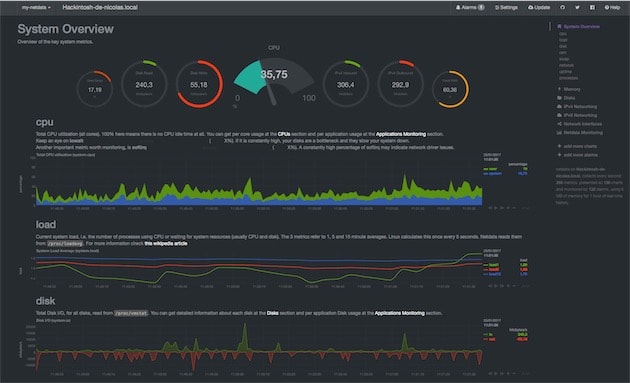Netdata is an open source tool to visualize and monitor in real time the performance of our system, optimized to obtain all kinds of data such as: CPU usage, disk activity, SQL queries, visits to a website, etc.
The tool is designed to visualize the activity in the greatest possible detail, allowing the user to get an overview of what is happening and what has just happened in his system.
features
Designed to be installed on each system without interrupting the applications running on it. It works according to the memory requirements specified by the user using only idle CPU cycles. Once the application starts, it will not perform disk I / O beyond registration. The tool is saved to disk at the end of its execution and loaded at startup.
By default it contains certain add-ons that collect key system information but its behavior is extensible through the use of its Add-in API.
Netdata can be run anywhere that runs a Linux kernel and its graphics can be embedded in web pages. It has an interface with customizable themes and can be customized through HTML. There are no dependencies since it works like your own web server with its static web files.
Installation of monitoring tool in CentOS 7
1- Install the following dependency before installing Netdata.
yum install zlib-devel gcc make git autoconf autogen automake pkgconfig psmisc -y
2- Clone the Netdata from git using the following command.
git clone https://github.com/firehol/netdata.git --depth=1
3- Navigate to the netdata directory after cloning.
cd netdata/
4- Run the script "netdata-installer.sh" to install netdata.
./netdata-installer.sh
|.-. .-. .-. .-. . netdata
| '-' '-' '-' '-' real-time performance monitoring, done right!
+----+-----+-----+-----+-----+-----+-----+-----+-----+-----+-----+-----+--->
You are about to install netdata on your system.
Installation Directories:
- the daemon at /usr/sbin/netdata
- config files in /etc/netdata
- web files in /usr/share/netdata
- plugins in /usr/libexec/netdata
- cache files in /var/cache/netdata
- db files in /var/lib/netdata
- log files in /var/log/netdata
- pid file at /var/run/netdata.pid
- logrotate file at /etc/logrotate.d/netdata
This installer allows you to change the installation path.
Press Control-C and execute the same command with --help for help.
5- Press ENTER to install netdata in our system.
6- We add the access port to netdata to our firewall.
firewall-cmd --zone=public --add-port=19999/tcp --permanent
We restart our firewall
systemctl restart firewalld
7- Access through the browser to netdata Monitoring.
http: //IP of my server: 19999





